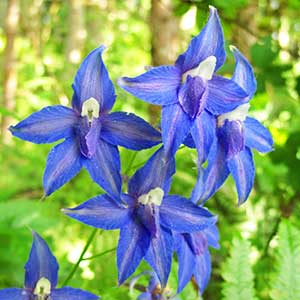Delphinium trolliifolium
Delphinium polycladon
Columbian larkspur, cow-poison, poison delphinium, poison larkspur
high mountain larkspur, mountain marsh larkspur
(40-)60-120(-180) cm;
base usually reddish, glabrous to puberulent.
(20-)60-100(-160) cm;
base reddish or not, glabrous.
blade ± pentagonal, 4-8 × 7-16 cm, margins ± incised, nearly glabrous; ultimate lobes 0-9, width 15-30 mm (basal), 5-20 mm (cauline), widest at middle or in proximal 1/2.
blade round to pentagonal, 1.5-7 × 2-14 cm, glabrous; ultimate lobes 3-12, width 4-30(-45) mm (basal), 3-30 mm (cauline).
(5-)14-40(-75)-flowered, ± open, at least 2 times longer than wide;
pedicel 1-4(-9) cm, puberulent to glabrous;
bracteoles (2-)6-12 mm from flowers, green, linear, 5-9(-14) mm, puberulent.
3-15(-35)-flowered, open, often ± secund;
pedicel 1-4(-15) cm, glabrous to puberulent;
bracteoles 2-8(-37) mm from flowers, green, linear, 4-7(-11) mm, nearly glabrous.
sepals dark blue, glabrous, lateral sepals spreading, (8-)14-21 × 5-9 mm, spurs straight or downcurved at apex, within 20° of horizontal, (10-)16-23 mm;
lower petal blades covering stamens, 5-10 mm, clefts 1.5-3 mm;
hairs sparse, mostly near junction of blade and claw, centered or on inner lobes, well dispersed, yellow.
sepals bluish purple, nearly glabrous, lateral sepals spreading, (10-)12-18 × 7-10 mm, spurs usually downcurved, ca. 30° below horizontal, 11-22 mm;
lower petal blades slightly elevated, ± exposing stamens, 4-6 mm, clefts 1-2 mm;
hairs mostly near base of cleft on inner lobes, yellow, sometimes white.
(15-)23-34 mm, 3.8-5.5 times longer than wide, glabrous.
13-20 mm, 3.5-4 times longer than wide, puberulent.
unwinged;
seed coats smooth.
unwinged;
seed coat cells with surfaces roughened.
= 16.
= 16.
Delphinium trolliifolium
Delphinium polycladon
Delphinium trolliifolium occurs in the northern Coast Range of California, the Columbia River Valley to just east of Mt. Hood, and the Willamette Valley of Oregon upstream to Lane County. California plants differ somewhat from Oregon plants in pubescence patterns and habitat preferences. Further study may show that two entities are involved here.
Hybrids between Delphinium trolliifolium and D. decorum, D. menziesii subsp. pallidum (D. ×pavonaceum Ewan, Peacock larkspur), D. nudicaule, D. nuttallianum, and D. nuttallii are known. Delphinium trolliifolium is likely to be confused only with D. bakeri. Refer to discussion under that species for differences.
(Discussion copyrighted by Flora of North America; reprinted with permission.)
Delphinium polycladon hybridizes with D. depauperatum and D. glaucum. Plants of D. polycladon are extremely variable. Individuals from very rocky, thin-soiled, sunny sites at higher elevations tend to be quite compact; they show the features of the species in a dwarfed state. Proximal internodes are especially shortened. Plants from areas of deeper soil (high or low elevations), especially those growing among shrubs, usually are much taller, with elongate proximal internodes, and other vegetative parts proportionally larger. Shorter plants may be confused with D. depauperatum or D. nuttallianum; see discussion under those species for distinguishing features. Taller plants may be confused with D. glaucum; they can be distinguished by their leaves predominately on proximal part of stem, sigmoid pedicel, and fewer flowers.
(Discussion copyrighted by Flora of North America; reprinted with permission.)


